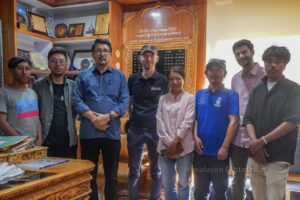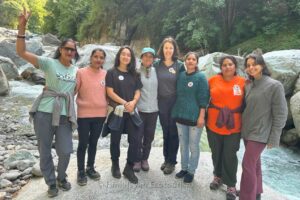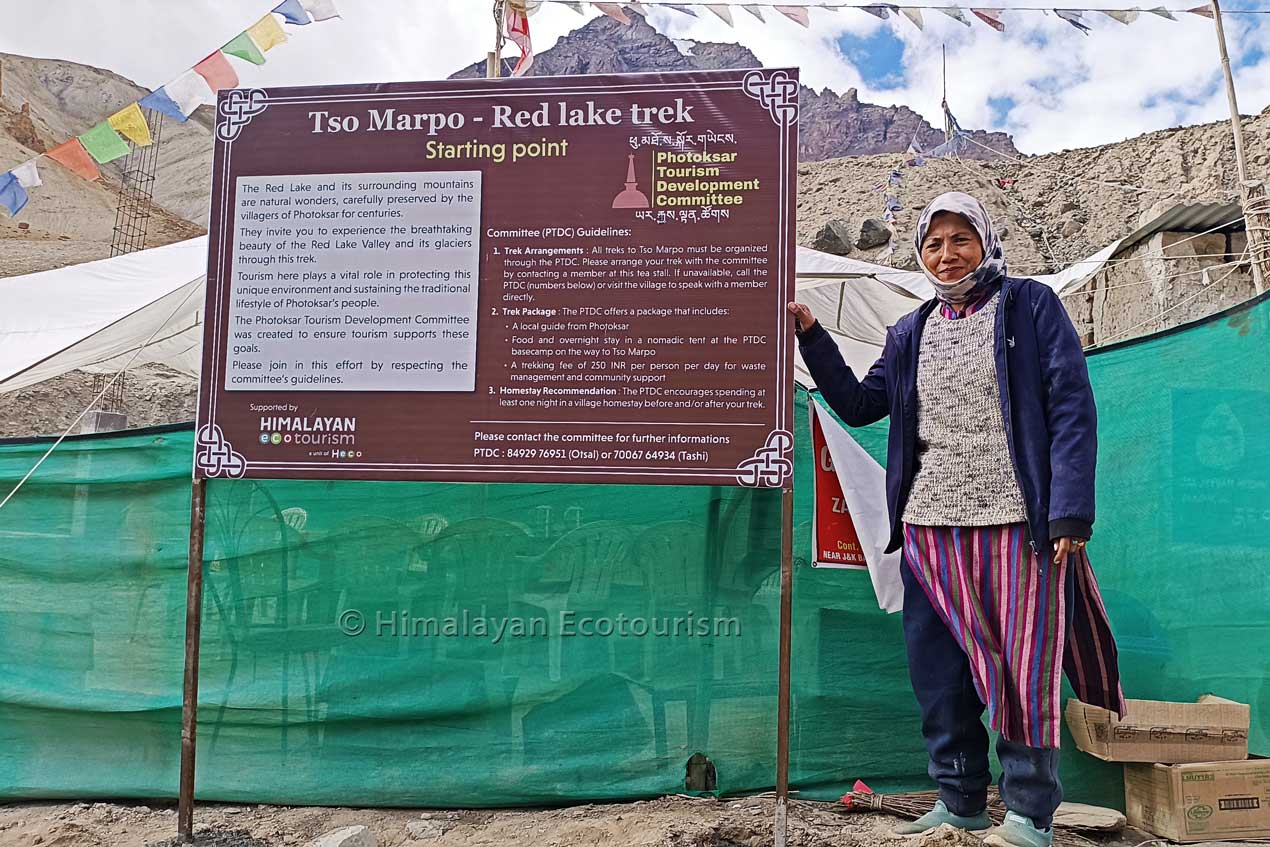When tourism can truly benefit a community and its environment : A social enterprise model
By Stephan, founder of Heco and Himalayan Ecotourism
The rapid expansion of tourism across the globe has brought both opportunities and challenges to local communities and their environments. Mainstream tourism enterprises often focus solely on profit maximization, frequently neglecting the long-term well-being of the communities and ecosystems.
At Himalayan Ecotourism (Heco), we have pioneered an approach that demonstrates how a tourism business can be reimagined to generate real, positive impact on both local communities and their natural surroundings. In this article, we will explore how our social enterprise model can reshape tourism to foster sustainable development and women’s empowerment, highlighting our initiatives in Himachal Pradesh and Ladakh as tangible examples.
The unsustainability of traditional tourism models
Conventional tourism often prioritizes financial gain over the well-being of host communities and ecosystems. This approach can lead to a variety of negative outcomes, including environmental degradation, cultural erosion, and socio-economic inequalities. Mass tourism in fragile ecosystems often overwhelms the local infrastructure, increasing pollution and waste, exhausting resources, and straining the delicate ecological balance.
Additionally, when tourism profits are centralized and funnelled to external operators or distant corporations, the benefits often bypass local communities, who remain disconnected from the profits of tourism happening in their own backyard. Women, in particular, often face exclusion from economic opportunities in such models. The absence of community control and shared benefits makes this system inherently unsustainable.
Reversing the narrative : A social enterprise approach
Heco has crafted a tourism model that centers on community empowerment, environmental stewardship, and gender equality. By blending tourism with social entrepreneurship, we enable local communities to become the stewards of their own futures.
Our social enterprise model integrates these core principles:
- Community Ownership and Control : Tourism should be managed by the people who are most affected by it. By giving communities the authority to control tourism activities, they not only reap economic benefits but also ensure that tourism practices respect local culture and ecological constraints.
- Environmental Conservation as a Priority : Our initiatives in the Himalayas go beyond reducing the negative impact of tourism – they actively contribute to environmental regeneration. Funds generated from tourism are reinvested in conservation programs, ensuring that tourism becomes a tool for sustaining the natural environment, not depleting it.
- Inclusivity and Fair Distribution of Wealth : We create mechanisms that ensure the equitable distribution of income from tourism activities, ensuring that all community members – especially the marginalized – share the benefits.
The Photoksar model : Reinventing tourism in Ladakh
Ladakh presents a unique opportunity to demonstrate the transformative potential of a social enterprise approach to tourism. Our ongoing work in the remote village of Photoksar is an exciting example of how we aim to reinvent tourism in Ladakh by placing control in the hands of local communities.

The PTDC and Heco team presenting their program to the Chief Counselor of Ladakh
Revitalizing Photoksar through sustainable tourism
Photoksar, a remote village nestled in the Zanskar range of Ladakh, has long faced economic challenges, with residents largely dependent on subsistence agriculture and livestock herding. The recent construction of a road through the Zanskar area has drastically reduced the number of trekkers passing through Photoksar, nearly eliminating a once-reliable income source for the villagers who hosted these travelers in their homes. Now, with virtually no trekkers visiting the village, one of the village’s few sources of income vanished. The community faces new economic challenges.
To address these challenges, we helped establish the Photoksar Tourism Development Committee (PTDC), a village-led organization focused on promoting sustainable tourism that benefits the community while preserving the delicate environment. In addition to assisting the PTDC with strategies for regulating tourism, setting fair prices, and encouraging responsible practices, Heco plays a pivotal role in developing new, meaningful tourism experiences in Photoksar.
We are actively creating activities that will draw responsible travelers back to the village, from cultural exchanges and guided hikes to unique eco-tourism experiences designed to showcase Photoksar’s natural beauty and traditional lifestyle. This initiative not only brings economic opportunity to the villagers but also fosters a type of tourism that respects and sustains the community’s heritage and environment.
Fair distribution of tourism revenue
One of the core aspects of the Photoksar model is the system of rotating homestay accommodations. Rather than competing for business, villagers in Photoksar operate under a shared income model where tourists are rotated among different households, ensuring that no single family dominates the tourism market. This system prevents competition and ensures an equitable distribution of income, fostering a stronger community bond.
Tso Marpo and Photoksar : a symbol of restored symbiosis
The Tso Marpo trek offers more than just breathtaking views of Ladakh’s high-altitude desert; it has become the flagship attraction for responsible tourism in Photoksar. Previously unknown to trekkers, this remote and sacred lake, nestled deep in the mountains, was identified by Himalayan Ecotourism and the Photoksar Tourism Development Committee (PTDC) as a potential draw to bring tourists back to the village. With Tso Marpo at its heart, the trek embodies a restored connection between villagers and their environment, fostering a model of tourism that respects both cultural and ecological significance. The promising results from the 2024 season show that this approach is beginning to work, drawing responsible travelers to experience Photoksar’s unique heritage and landscape.
To ensure that tourism remains sustainable and that the villagers benefit directly, trekkers must seek permission from the PTDC before embarking on the journey. Along with this permission, trekkers are required to pay a social and conservation contribution fee. This fee supports the community’s collective efforts in maintaining the trail, protecting the area’s fragile ecosystem, and offering financial assistance to villagers who are starting or improving their homestays. All guides for the trek are from Photoksar, guaranteeing that the income stays within the community.
A unique highlight of the Tso Marpo trek is the traditional-style nomadic camp, crafted from yak wool, which serves as the only accommodation option for overnight stays. This camp provides visitors with an authentic cultural experience while ensuring that all tourism revenue directly benefits the people of Photoksar. By centralizing overnight stays at this camp, the PTDC can carefully manage visitor numbers, allowing the local community to maintain control over tourism development. This approach safeguards the region’s natural beauty, respects its ecological capacity, and fosters sustainable growth that aligns with the community’s values.
The connection between the villagers and their environment is beautifully restored through this initiative. Tso Marpo, once a sacred and remote spot, now generates income for the community, and in return, the villagers are dedicated to protecting and conserving the lake and the surrounding areas. This symbiosis between the people and their environment exemplifies the core of responsible tourism, where economic benefits and environmental stewardship go hand in hand.
Read more about this program here.
Women’s empowerment : A key to success
Women’s empowerment lies at the heart of Heco’s work, and we have seen firsthand how involving women in income generating activities can strengthen both the community and the environment. Historically, women in rural areas of India have been sidelined from economic participation. At Heco, we are changing this by involving women in decision-making roles and offering them opportunities for entrepreneurship and skill development.

A women-led trek in the Great Himalayan National Park with Shivya Nath
Case Study: Women as trekking guides in Himachal Pradesh
In the vicinity of the Great Himalayan National Park, Heco’s initiative has demonstrated that tourism can be a powerful tool for women’s empowerment and economic inclusion. In a traditionally male-dominated field like trekking, Heco has created opportunities for women to become trekking guides, a role that not only allows them to break into the tourism industry but also gain financial independence. By training these women in guiding skills, safety, and environmental conservation, the initiative has provided them with a new source of income and a sense of purpose.
This initiative aims to shift the status quo, where women are often confined to roles with limited economic prospects. As trekking guides, these women are at the forefront of tourism, interacting with travelers, educating them about the environment, and embodying the shift towards more equitable gender roles in their community.
The positive impact of this initiative extends far beyond the women involved; it challenges the traditional societal norms in the village and inspires a broader cultural shift. By training women as trekking guides, we are actively questioning the local conservative system and confronting long-standing barriers such as the caste system. This initiative is fostering an environment where other women are encouraged to step forward, seek independence, and break free from limiting roles. Ultimately, our work is making the local community more progressive, paving the way for a society where equality and conservation are not just ideals but real, tangible values embraced by all.
Read more about this program here.
Why our social enterprise model works
The success of our approach in both Himachal Pradesh and Ladakh demonstrates that our social enterprise model is uniquely positioned to create win-win situations for communities and the environment. Traditional tourism models tend to fragment communities and place enormous pressure on natural ecosystems. In contrast, our business model prioritizes long-term sustainability over short-term profits.
Environmental Gains : The benefits of our model extend beyond reinvesting tourism revenues into conservation programs. A critical element is raising community awareness about their responsibility to protect and regenerate their environment. Through community-managed tourism, locals not only benefit financially but also become stewards of the natural resources they rely on, ensuring long-term environmental sustainability.
Social and Economic Empowerment : In a global system where wealth often concentrates in urban areas, our sustainable tourism model redirects financial resources from urban centers to rural communities. This approach empowers local populations to become the guardians of their environment while benefiting from tourism. By involving women in particular, we ensure that these benefits are equitably distributed, leading to more inclusive, community-driven development.
A Replicable Model : Perhaps the most exciting aspect of our work is its replicability. The social enterprise model we’ve developed can be applied in other regions, helping communities harness the power of tourism for positive change.
Conclusion
Tourism can be a force for good, but only when designed with a commitment to sustainability and inclusivity. Heco’s social enterprise model is proving that when local communities are empowered to control tourism in their own villages, the benefits can extend far beyond financial gain. By integrating environmental conservation, women’s empowerment, and sustainable tourism practices, we are building a model that uplifts communities and protects the natural world – one village at a time.
You can read the article of Shivya Nath about Community-Based Tourism for more ideas and case studies.







